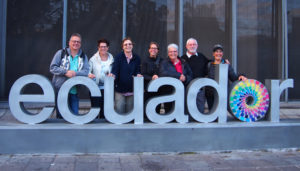 At an elevation of 2850 metres Quito, Ecuador is the one of the world’s highest cities. The city is in a valley between the mountains, it’s only 6 kilometres wide and 40 kilometres long, so exploring the city can involve large amount of walking up and down. Arriving in Quito may have you feeling light headed and short of breath, but just remember to take it slow, drink lots of water and allow yourself to acclimatise to the altitude.
At an elevation of 2850 metres Quito, Ecuador is the one of the world’s highest cities. The city is in a valley between the mountains, it’s only 6 kilometres wide and 40 kilometres long, so exploring the city can involve large amount of walking up and down. Arriving in Quito may have you feeling light headed and short of breath, but just remember to take it slow, drink lots of water and allow yourself to acclimatise to the altitude.
The city of Quito gained its name as an adaptation of the local Quitu people. It was a major Inca city, until the Spanish arrived and conquered it in 1534. The city was built up by the Spaniards from the 17th century, and it is many of these buildings which remain in the Old Town of Quito. The old town is UNESCO World Heritage listed and is the most well preserved old town in the Americas.
Quito today is a bustling city with a population of 2.6 million. Its primary export is oil, which unfortunately can be linked to the crash of the Ecuadorian currency and other problems. Other main exports include flowers, bananas, cacao beans and tuna.
Quito is a safe and pleasant city to explore on foot, albeit at a much slower pace than normal due to the altitude. There were a number of things I did around town including a free walking tour; Middle of the World tour; I visited the Basilica; Plaza Grande, the Cathedral; the Jesuit church, Iglesia de Compañia de Jesus; Monastery of San Francisco; Iglesia de Santo Domingo, La Ronda and also; the Teleferiqo.
Some places that were recommended as good to see, that I didn’t get around to seeing include: El Pancillo and El Capilla del Hombre/Guayasamin Museum.
Free Walking Tour run by Community Hostel
When: 10:30am daily (except Sunday)
Cost: Free, but tips are welcome
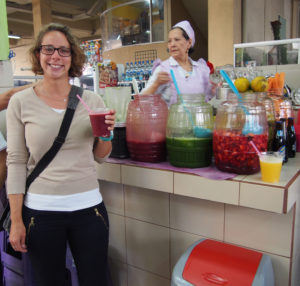 Our tour guide Andrea from Community Hostel, provided us with a fantastic tour of her town. She is a Quiteñan and is very proud of her city. We started the tour at Community Hostel and made our first stop at the Central Market, where we learned about the local foods.
Our tour guide Andrea from Community Hostel, provided us with a fantastic tour of her town. She is a Quiteñan and is very proud of her city. We started the tour at Community Hostel and made our first stop at the Central Market, where we learned about the local foods.
Firstly, Ecuadorians love sugar! They will take any opportunity to put sugar on or in something, such as the delicious Jugo de Mora (Blackberry juice, sweetened with of course, sugar).
Andrea also advised us that Ecuadorians have discovered the cure for a hangover; Encebollada is some form of fish and onion broth that you see advertised all over the place.
After sampling some of the local fresh juice, we continued our tour into the old town where we heard some of the history of Quito and Ecuador and Andrea pointed out the significant buildings around town, as well as showing us some of the best views within the city.
Middle of the World Tour run by Community Hostel
When: 2:30pm daily (except Sunday) from the Community Hostel
Cost: $10 plus museum entrance fees. Intiñan Museum $4 and I did not pay to enter the ‘fake’ equator line.
 In the days of the Spaniards, the equator line was identified running through the north of Quito, a monument and small city were built for tourists to come and visit. Some years later, using the new technology of GPS, the real equator line was discovered 200-300 metres away from the Mitad del Mundo museum, here the Intiñan Museum was built.
In the days of the Spaniards, the equator line was identified running through the north of Quito, a monument and small city were built for tourists to come and visit. Some years later, using the new technology of GPS, the real equator line was discovered 200-300 metres away from the Mitad del Mundo museum, here the Intiñan Museum was built.
In a guided tour of the Intiñan Museum you are taught a small amount about some of the local people of Ecuador such as the Shuar Tribe who were the tribe of people known for shrinking heads to keep as trophies or allow their revered elders to live on. We also were able to perform small experiments on the equator line such as seeing water swirl different directions in the two different hemispheres, and balancing a raw egg on the head of a nail. I really enjoyed my visit to this small museum and the little experiments were fascinating and fun!
Basílica Voto de Nacional
Cost: $2 to climb the towers and $2 to visit the church.
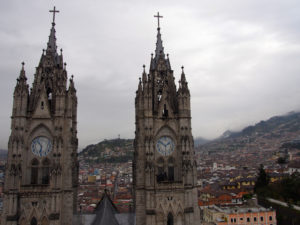 The Basilica Voto de Nacional is the largest neo-gothic church in the Americas. It is visually comparable to the Notre Dame in Paris, except the gargoyles on the sides of the church’s exterior are native animals of Ecuador. The church interior is beautiful and the main nave is lined with stained glass windows. My favourite part of the basilica was not the church interior, rather the towers. Climbing the main tower and bell tower of the Basilica was one of my most enjoyable experiences in Quito. I had the chance to walk rickety timber boardwalks and exposed steel ladders to pop out at the top of these towers to gain a magnificent view of the city.
The Basilica Voto de Nacional is the largest neo-gothic church in the Americas. It is visually comparable to the Notre Dame in Paris, except the gargoyles on the sides of the church’s exterior are native animals of Ecuador. The church interior is beautiful and the main nave is lined with stained glass windows. My favourite part of the basilica was not the church interior, rather the towers. Climbing the main tower and bell tower of the Basilica was one of my most enjoyable experiences in Quito. I had the chance to walk rickety timber boardwalks and exposed steel ladders to pop out at the top of these towers to gain a magnificent view of the city.
Plaza Grande
Cost: Free
 Plaza Grande is essentially the central point of the old town. It is a large green plaza, with a sculpture of independence in the centre. It is clearly the place where locals come and hang out to enjoy the sunshine, relax and read the paper or try to sell their goods. The plaza is flanked by beautiful old buildings on three sides: the Archbishops palace which has been converted into shops and restaurants, the Presidential Palace and the Cathedral. The fourth side of the plaza houses the tourism office in a modern building that doesn’t suit the old town at all.
Plaza Grande is essentially the central point of the old town. It is a large green plaza, with a sculpture of independence in the centre. It is clearly the place where locals come and hang out to enjoy the sunshine, relax and read the paper or try to sell their goods. The plaza is flanked by beautiful old buildings on three sides: the Archbishops palace which has been converted into shops and restaurants, the Presidential Palace and the Cathedral. The fourth side of the plaza houses the tourism office in a modern building that doesn’t suit the old town at all.
Having a coffee at one of the traditional old cafes under the Cathedral or sitting on one of the park benches enjoying a freshly made juice is a great way to spend the time and people watch as the locals go about their business.
La Catedral
Cost: $2
The Cathedral is the main church on Plaza Grande at the center of the Old Town. It was quite a lovely church, but in my opinion, many other churches in the area are more spectacular.
Iglesia de Compañia de Jesus
Cost: $5, or free on the first Sunday of every month. There is an additional cost to climb to the cupola (the cupola closes before the church and I didn’t have the chance to do this)
The Iglesia de Compañia de Jesus is the most elaborately detailed church I have seen. The rich Jesuits built the church over a period of 160 years. The elaborate and intricate designs are both external and internal. The value of the internal design is however much higher, with a huge number of surfaces being covered in gold leaf. Most of the interior glitters with gold.
Monastery of San Francisco
Cost: $2
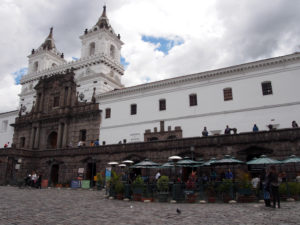 The long white building of the Monastery of San Francisco is a place to visit if you enjoy religious art and churches. It is the largest colonial structure in the city and took 70 years to build. Your entry free provides access to a small museum or gallery, a lovely internal garden courtyard and the church. The church is rather spectacular to see, with bright colours, elaborate paintings and highly detailed timber work. Unless you are particularly religious, it is probably not a place that would be high on my list of recommended places to visit. The plaza in front of the Monastery is busy with the construction of a new metro system, but still is a great place to buy from local artisans wandering through or stop and enjoy a coffee.
The long white building of the Monastery of San Francisco is a place to visit if you enjoy religious art and churches. It is the largest colonial structure in the city and took 70 years to build. Your entry free provides access to a small museum or gallery, a lovely internal garden courtyard and the church. The church is rather spectacular to see, with bright colours, elaborate paintings and highly detailed timber work. Unless you are particularly religious, it is probably not a place that would be high on my list of recommended places to visit. The plaza in front of the Monastery is busy with the construction of a new metro system, but still is a great place to buy from local artisans wandering through or stop and enjoy a coffee.
Iglesia de Santo Domingo
Cost: Free
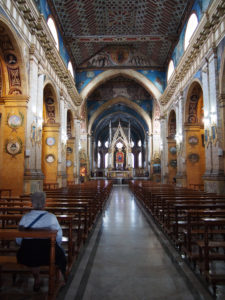 On the Plaza Santo Domingo is the Church of Santo Domingo. It is a beautiful church with fascinating bright blue patterned paintwork. The plaza is a pleasant place to wander through, where local food sellers occasionally set up stalls. It’s a little out of the main hub of the old town, but to me the lack of tourists buzzing around made my visit that little bit more pleasant and culturally rich.
On the Plaza Santo Domingo is the Church of Santo Domingo. It is a beautiful church with fascinating bright blue patterned paintwork. The plaza is a pleasant place to wander through, where local food sellers occasionally set up stalls. It’s a little out of the main hub of the old town, but to me the lack of tourists buzzing around made my visit that little bit more pleasant and culturally rich.
La Ronda
Cost: Free
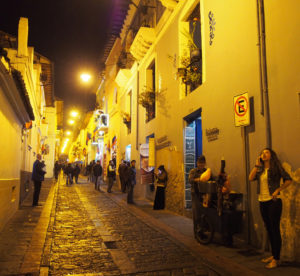 Calle La Ronda is the oldest street in Quito. The street houses several artisan shops for chocolate, coffee, honey, metal work, timber work etc. After the sun sets is when the street really comes to life with busy restaurants and bars. The thing to do is stop in for a giant cheese empanada and the traditional drink, Canelazo while listening to live music.
Calle La Ronda is the oldest street in Quito. The street houses several artisan shops for chocolate, coffee, honey, metal work, timber work etc. After the sun sets is when the street really comes to life with busy restaurants and bars. The thing to do is stop in for a giant cheese empanada and the traditional drink, Canelazo while listening to live music.
TeleferiQo
Cost: $8
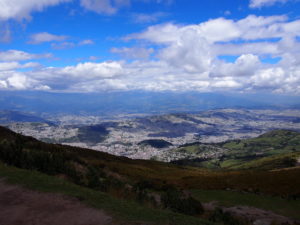 Getting a taxi or bus out to the TeleferiQo is a fabulous idea. You ride the cable car up to a height of 4100metres and are afforded stunning views over the whole city of Quito. It is from here that you are able to appreciate just how mountainous the town is, despite it being in a valley. From the arrival station you can continue up by hiking or riding a horse to the upper station at 4800metres. With friends and family, we decided the lower station was enough for us.
Getting a taxi or bus out to the TeleferiQo is a fabulous idea. You ride the cable car up to a height of 4100metres and are afforded stunning views over the whole city of Quito. It is from here that you are able to appreciate just how mountainous the town is, despite it being in a valley. From the arrival station you can continue up by hiking or riding a horse to the upper station at 4800metres. With friends and family, we decided the lower station was enough for us.
Artisan Market
Cost: Free
In the newer suburb of Mariscal is an artisan market with handicrafts made by local Quiteñans and Otavaleñans. If you don’t have the time to visit the markets in Otavalo, then this market is a fantastic alternative option.
Centre for Contemporary Arts
Cost: Free
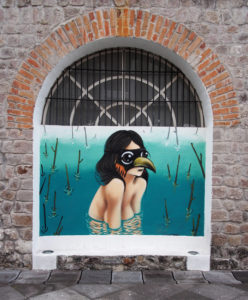 I’m not particularly into art or museums, but my dorm buddy in Quito was, so I figured I would tag along. I was glad I did.
I’m not particularly into art or museums, but my dorm buddy in Quito was, so I figured I would tag along. I was glad I did.
The Contemporary Arts Museum is free to enter. It is located in a position on the hill which has a good view of the city and on the way there I walked past loads of street art, which I enjoyed photographing.
The arts museum was housed in a fascinating building which was a combination of old and new design styles. The few art installations insides the museum were also quite fascinating, though for me the building itself was the highlight.
Bucketpass
The bucketpass is a pass where you pay a set price and get access to a certain number of attractions/visits and it works out to be slightly cheaper than all the separate ticket prices.
I only learned of the bucketpass after having explored Quito. There are numerous things covered by the pass that I did not see. However based on your interests, it may be worth looking into.
There is also a bucketpass for the Galapagos Islands.
Eating
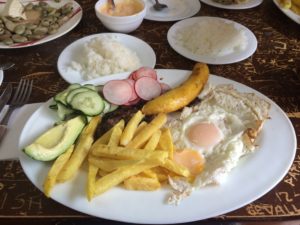 Food in Ecuador is reasonably cheap and I always try to eat the local cuisine in restaurants where the locals might eat.
Food in Ecuador is reasonably cheap and I always try to eat the local cuisine in restaurants where the locals might eat.
Breakfast: I always book into accommodation where breakfast is provided.
Lunch: Typically a set menu with 3 courses for $3.
Dinner: One course with meat, rice and lentils or beans, usually around $5.
A good area to find food is around Foch Plaza in the suburb called Mariscal. In the middle of the plaza you will find more trendy, modern restaurants which are also more expensive. In the streets just off the plaza you will find more local food at a more affordable price.
Accommodation
For a private room in a budget hotel you can expect to pay around $20-$30 per night.
For a bed in a hostel dorm room you can expect to pay somewhere around $9 – $15
As per usual, whether it is a hostel or hotel, I book using booking.com
Transport
Buses around Quito and beyond cost on average $1 per hour of travel, which is quite cheap. The biggest problem is that there is a bus station at either end of the city, which take an hour to get to. THEN you can take your bus to your onward destination. A taxi to one of these stations may cost up to $10.
Taxis around town are hit and miss. When you catch a taxi, make sure it is Taxi Seguro (secure/safe taxi), check that it has cameras and that it uses a meter. If it doesn’t use a meter, negotiate your price before getting in. When the meter is on, the prices are typically really good.
Walk.. walking and getting lost in a new city is a very enjoyable experience and you come across all sorts of interesting things. I consider Quito safe to explore by foot, but I would not recommend walking up the hill up to El Pancillo. The area around El Pancillo is where all the thieves used to hang out, and the place you are most likely to be mugged.
Airport transfers, with a bus you can expect to pay $2 between Quito and the airport. For a taxi the standard rate is $30.
